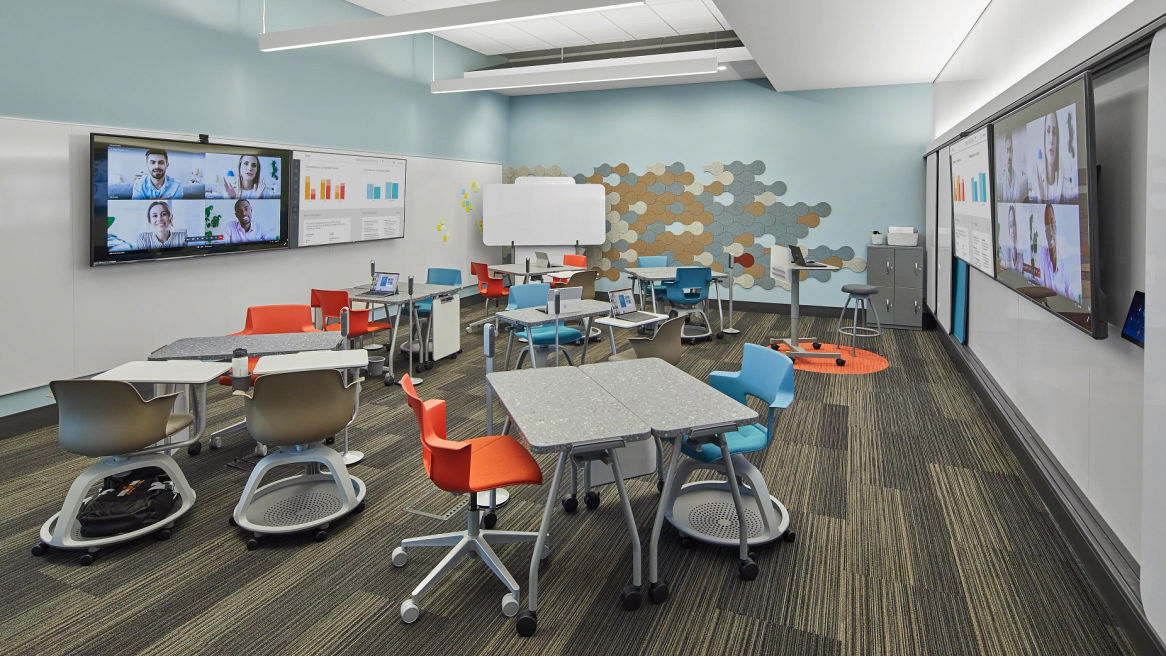Indiana University, Microsoft + Steelcase Explore Hybrid Learning
Our experts share how hybrid is changing the ways people learn and what they are doing about it.
A hybrid approach to work and education is changing how people learn. The pandemic fast-forwarded opportunities for hybrid learning to thrive as it never has before, from kindergarten to corporate environments. Organizations are onboarding, reskilling and upskilling people at a rapid pace while schools and universities have been learning to quickly adapt to serve both in-person and remote learners.
Hybrid learners have new needs and expectations, and it can be hard. The challenge is to rethink strategies, spaces, and technologies to help learners and educators, no matter what side of the camera they’re on. Host, Katie Pace, Steelcase global communications director, moderated an expert panel on hybrid learning (watch now on demand).
Our experts:
- Rob Curtin, Director Higher Education, Microsoft Worldwide Education Industry
- Tim Elms, Director, Steelcase Learning
- Julie Anne Johnston, Director of Learning Spaces, Indiana University
Katie Pace: How are you handling learning right now — in-person, virtual or hybrid?
Julie Anne Johnston: Our students are back on campus, but it’s a new environment. Classrooms need to be more high-flex. And we’re also looking at our new normal, which is 49,992 students taking one or more classes online. That’s 55% of IU students — very different from before.
Rob Curtin: I’m hearing from universities and organizations around the world that everybody’s connected to choice. The traditional walls of resistance have been blown away by the pandemic. I like coming to the office, just as so many students and faculty value the campus experience. But individuals are diverse. We fall on a spectrum of lifestyles, life stages, and even learning styles. We have shown we can accommodate remote workers, and remote learners. That’s the new standard and we aren’t going back.
Tim Elms: One common thread across education and the corporate world is that people are now intentionally bringing remote participants into the physical space. People need to be seen and heard. They need to follow the action, whether they’re in a classroom or a meeting. As simple as it sounds, a lot needs to change to accommodate that.
KP: How has learning changed at IU as a result of the pandemic and bringing people back to campus?
JJ: Our faculty and students are ripe for all types of new experiences. They have a level of comfort with technologies like never before. We’ve launched a brand new creative digital literacy initiative called the Digital Gardener to ensure faculty and students have a broad understanding of digital literacy from a variety of components. The initiative is unique in that it has both a faculty and student focus. In addition, we have created and installed seven new production studios ranging from high-end with actual operators to what we would call self-service. Now, we can have high-quality video for learning online and then use the classroom time for engagement and conversation. That flipped classroom approach has never been more important.
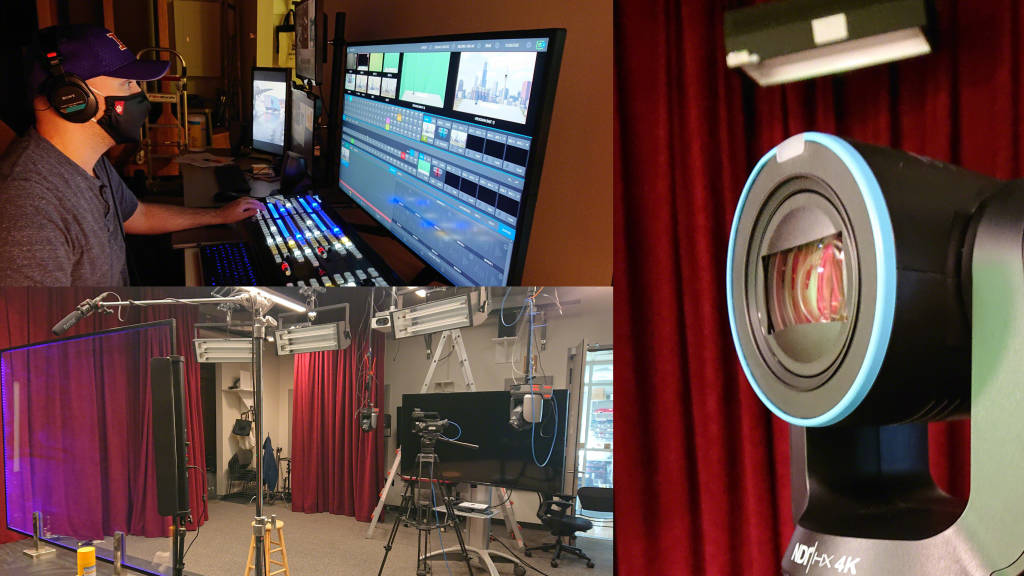
KP: What are some of the challenges you’re seeing when it comes to hybrid learning for both educators and learners?
RC: It is true that students and faculty covet that campus experience, but there are times when they will choose to be remote. Hybrid pedagogy is a challenge. Simultaneously engaging in-class and remote participants puts a lot of pressure on faculty, who now have to be both lecturer and producer. Students are still adapting to hybrid environments, and adopting behavioral norms such as joining the remote session from within the classroom to participate in the chat and have video equity. Many faculty are rethinking the entire experience, cutting content into shorter segments that can be digested asynchronously, and rethinking the lecture time for more active engagement.
There’s always been innovation, but what’s different now is we’re seeing it at scale. And this is creating institutional opportunity as well around capacity and space planning. For instance we can not accommodate 50 students in a classroom with 30 seats. How will a student indicate if they are coming to class? What happens if we get into overbooking situations? We have a lot to learn over the next couple of years.
KP: Steelcase Learning is testing some new hybrid learning spaces to get at some of those challenges. Tim, can you share what you’re testing?
TE: We are prototyping a space we call the Learning Studio. It’s a cloud-based environment. So, rather than walk in with a laptop and having to find your files, you literally walk in, log into the Microsoft Surface Hub which is mounted on a Steelcase Roam mobile stand, and the instructor or presenter downloads their content, interacting with it through the cloud.

In this space, the virtual world meets the in-room experience. The instructor can engage with the students in the room or those joining remotely. A large display brings remote participants in, literally allowing eye-to-eye contact. There’s enhanced audio in the space as well. And everyone in the space uses Microsoft Teams whether they are remote or not so they can share digital content in real time. There’s power throughout the space to support personal devices. The arrangement of the space and organic shape of the tables allows everything to stay in view of the camera. This is one of several experiments we’re running here at Steelcase based on talking to customers, our tech partners and living this journey ourselves.
Take a Virtual Tour
Get in touch with us to register for a virtual tour of our hybrid learning spaces.
Register Now
KP: What types of hybrid learning environments are you exploring at IU?
JJ: We’ve really transformed our classroom learning space design discussions to meet a new standard around quality audio, video and content sharing. Another new conversation is: What are we going to do with these large lecture halls? How can they be more engaging? One of our solutions is a more immersive lecture space. The instructors can set the stage for students in the room with biophilia and nature imagery so they can set the tone for the students in the space.
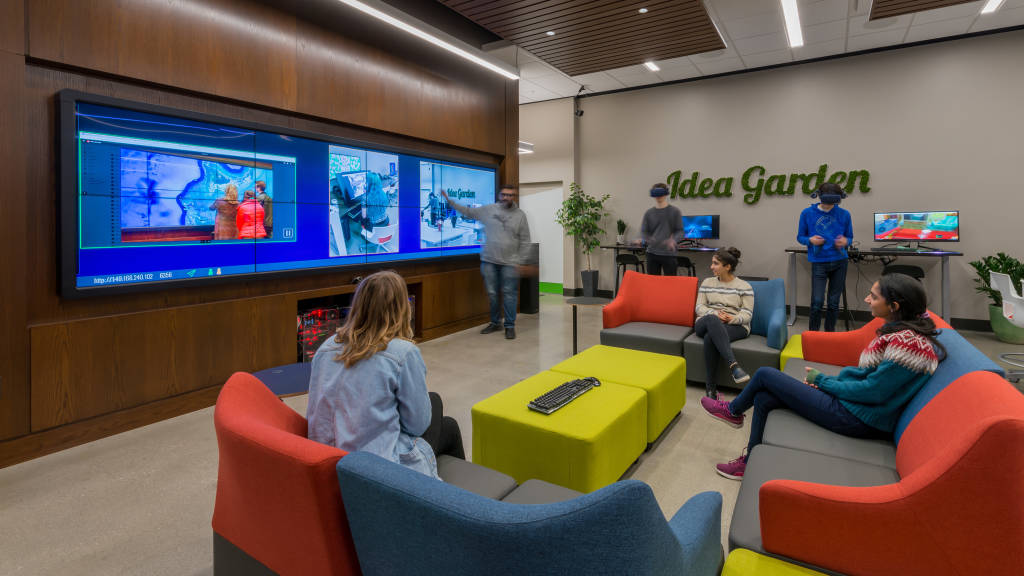
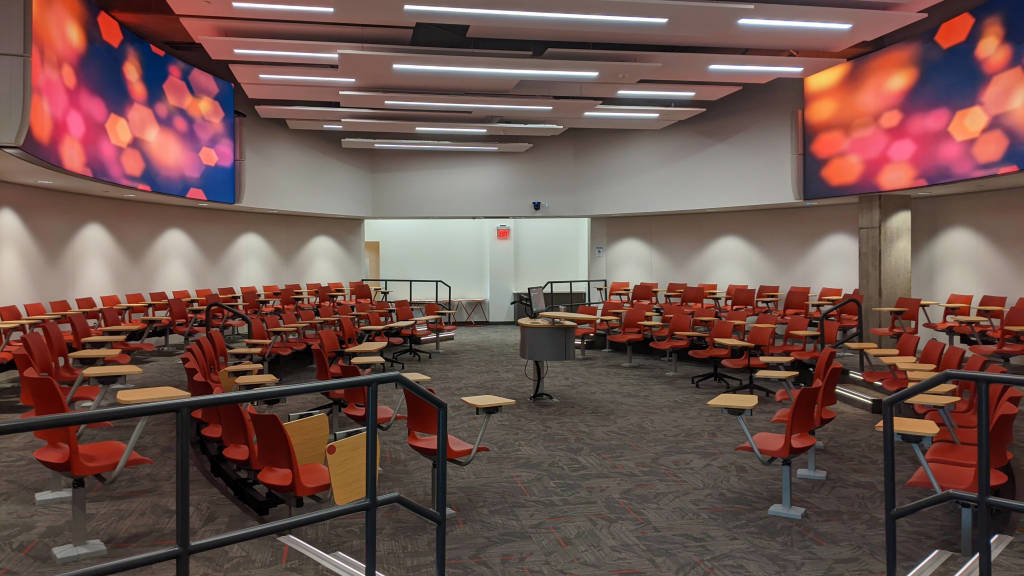
Universities are going to have to pivot and create more unique creative spaces that are more intimate. Our Idea Garden feels like home. After spending a year at home, we know students coming back are looking for something a little bit different. They’re looking for technology to explore and ways to engage. This particular space has virtual reality 3D, but also immersive video where you can have a variety of meetings with high-end cameras where you can see and hear all the students.
KP: How is Microsoft coaching clients to integrate technology into these hybrid learning spaces?
RC: One of the big issues we talk about is striving for equity and inclusion. Does everyone have the same quality laptop? An appropriate camera? You don’t want people in the room having one conversation and people out of the room having another. The role of the chat window is important, as is taking a poll and having everyone respond without speaking over each other. Ultimately, it comes down to practice and experience. What’s asynchronous versus synchronous? There’s going to be experimentation. Every moment is going to reveal the best way to do it. We’re going to learn how people work and how we create collaborative moments within smaller groups as part of a larger gathering. I don’t have any fear that hybrid is going to overwhelm higher ed. It’s really an opportunity to reach and include more learners.
KP: Tim, what are the guiding principles you’re thinking about when designing these types of spaces?
TE: There’s a high demand in these spaces for performance and technology in physical space coming together in a very intentional way. To do that, we are thinking about three key concepts — inclusion, equity and ease. When it comes to inclusion, we’re literally embracing the remote participants in these spaces. We’re using larger displays, so it’s not just a little thumbnail of a person. And mobile displays let you pull remote participants into a breakout conversation. With equity, it’s about making sure everyone can see and be seen, hear and be heard and can contribute to content creation.
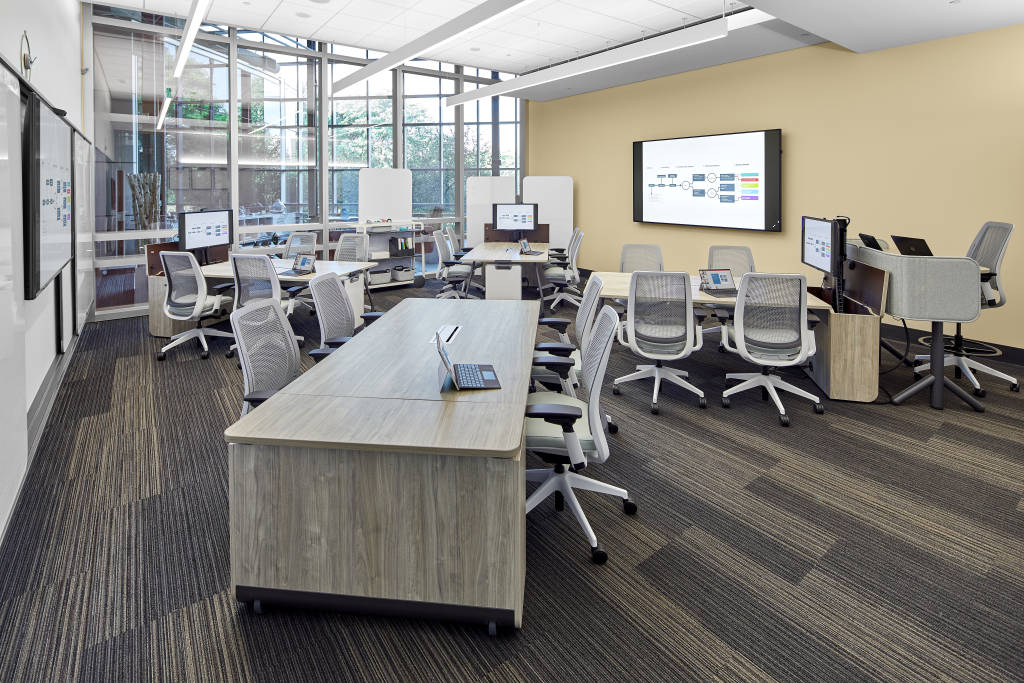
Finally, when it comes to ease, people need flexibility and easy access to power and technology. You can solve for that without tethering to a table, floor or wall. Mobile power and mobile digital display carts let learning sessions shift into peer-to-peer learning moments or small-group conversations without making it hard to move around and bring your technology with you.
KP: How is IU addressing adapting spaces to accommodate more hybrid learning?
JJ: We’ve implemented some of those Steelcase solutions. Sufficient power for students and faculty that allows them to move is now a standard when we renovate a space. We’re launching our own pilot classroom called the Alcove where we are untethering the instructor from the podium. The instructor can walk in with their own laptop and connect to all of our high-end cameras and audio immediately which can be controlled by the laptop. We also are working on smart classrooms that know the instructor and what type of setting is needed when they walk into the room. We want to capture the whiteboard content so it can be viewed and edited later, and distributed students can see it. You have to start and really experiment with faculty who are willing to provide feedback. Then, you can scale.
Katie Pace: How is Microsoft advising leaders to plan for a shift to hybrid learning?
RC: Once we had to force the spaces to accommodate people who brought in technology. But now we have technology that’s bringing in people. That’s progress and a big change. When I advise leaders, I like to share three E’s to consider.
- Empathy – People take pride in being good at something. And when you change the way the game is played, they’re going to push back. We have to lead with empathy for students going through a different experience, but most importantly, faculty and educators who are being asked to do something differently that they thought they were good at.
- Experience – Create and lead new experiences that early adopters can test. If you show them that the experience is indeed better, they’ll support the evolution of hybrid learning.
- Equity – We have to think about how we’re building personal devices into the experience. Is it part of the cost of attendance? Would it be eligible for aid? We have to be respectful. We don’t want to differentiate between those with the sponsored device and the privileged device. We’ve seen what’s happened in K-12 where they rapidly got everyone a low-cost device. But then you had the haves that had a device from their parents and the have nots with the standard issue device.
KP: What’s the one takeaway you would leave people with when it comes to hybrid learning?
RC: Experience matters for diverse constituents. So, the one-size-fits all concept is fundamentally dead. That’s the hard part. You have to think about experience through the eyes of many different personas meeting at the same time. Historically, we have been talking about a remote learning experience or in-class experience. Now, experience has to accommodate diversity of learning style, engagement style and attendance model. I would recommend using persona models to think through the experience for each type of learner or presenter.
JJ: Every space is a learning space. We’ve been so focused on the physical walls of a classroom, but now we need to become experts in connecting students at a distance including outdoors. We’re redesigning outdoor areas into quality learning spaces for our campus which means improving Wi-Fi access and providing better tools and affordances. We need to ask: What can we do to create an experience where learning can happen wherever learners are?
TE: Hybrid learning is all about braiding the physical and digital world. There are important intersection points between technology and physical space that need to be addressed to solve for a more equitable, engaging and easy experience. You need to adapt to ensure everyone can see and hear, has access to power and can interact with content. How does the architecture of the space impact sound quality? Does the lighting make it easier or harder to see? Are remote participants stuck on the wall or can they be moved around the room? Moving forward, we need a comprehensive approach to make hybrid learning work as we literally braid the physical and digital world.
AUDIENCE POLL RESULTS
(Total of 525 audience members. They were allowed to select more than one answer.)
Tell us what best identifies your role.
48% Architect & designer
18% Educator or education leadership
13% Other
9% Corporate strategy or leadership
9% Real estate and facilities management
7% Information technology
5% Corporate learning
2% Human resources
How are you navigating hybrid learning?
32% Accessing lots of support to understand how to implement better hybrid solutions
30% Taking small steps and focused on slow implementation
27% Moving ahead more quickly because we had a lot in place pre-pandemic
13% It is currently challenging and chaotic
9% We are not implementing hybrid learning
Of these, what is the biggest opportunity from implementing hybrid learning?
45% Greater access to learning for participants
34% Giving a voice to all participants using different technology
28% Greater potential reach for institutions or organizations
25% Enhanced efficiencies due to technology and tools
Of these, what is the biggest challenge with hybrid learning?
58% Disparity between in-person and remote participants
23% Building community
21% Instructor adoption
20% Technology integration
19% Increased cost
16% Knowing the best types of activities to engage learners
For hybrid learning to be successful, what does your organization or institution need to improve?
50% Hybrid collaboration spaces
40% Training and resources for instructors to leverage the space and technology
27% In-office or classroom technology
26% Clearly-communicated hybrid learning policies
21% Furniture and technology for learning from home
17% Private individual spaces for hybrid learning
What new experiences are you exploring in response to hybrid learning needs?
40% All of the above
35% Enhanced technology integration
26% Updating learning spaces
18% New learning strategies
13% Additional instructor training
7% We have not started exploring hybrid learning
 Rob Curtin is Director of Higher Education for Microsoft’s Worldwide Education Industry. Starting at Microsoft over 30 Years ago, Rob has always served education. He is most passionate about technologies that help institutions connect learners with the experiences and opportunities to realize their dreams.
Rob Curtin is Director of Higher Education for Microsoft’s Worldwide Education Industry. Starting at Microsoft over 30 Years ago, Rob has always served education. He is most passionate about technologies that help institutions connect learners with the experiences and opportunities to realize their dreams.
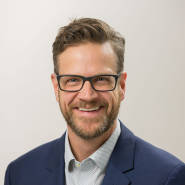 Tim Elms leads Steelcase Learning globally. He has previously led the Steelcase Workplace Innovation Team leveraging design thinking methodology to define and solve for emerging needs of the workplace. Tim now applies his 20+ years experience in workplace, innovation, technology, and education to solving for the hybrid experience in learning and meeting spaces.
Tim Elms leads Steelcase Learning globally. He has previously led the Steelcase Workplace Innovation Team leveraging design thinking methodology to define and solve for emerging needs of the workplace. Tim now applies his 20+ years experience in workplace, innovation, technology, and education to solving for the hybrid experience in learning and meeting spaces.
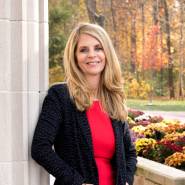 Julie Johnston is the Director of Learning Spaces for Indiana University. This position manages four entities of UITS Learning Technologies: Classroom Technology Services, Learning Space Design, Collaboration Technologies, and Student Technology Computing. Along with managing these services, she is ultimately responsible for the technology design of Learning Spaces for the campus, specifically active learning classrooms, informal learning spaces, and student technology center spaces.
Julie Johnston is the Director of Learning Spaces for Indiana University. This position manages four entities of UITS Learning Technologies: Classroom Technology Services, Learning Space Design, Collaboration Technologies, and Student Technology Computing. Along with managing these services, she is ultimately responsible for the technology design of Learning Spaces for the campus, specifically active learning classrooms, informal learning spaces, and student technology center spaces.

